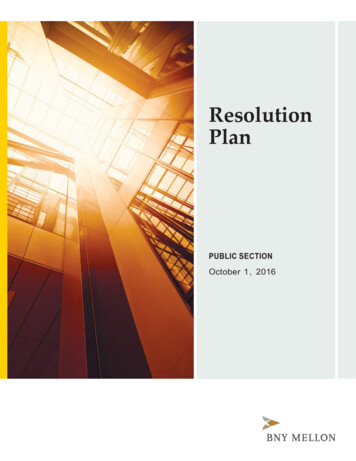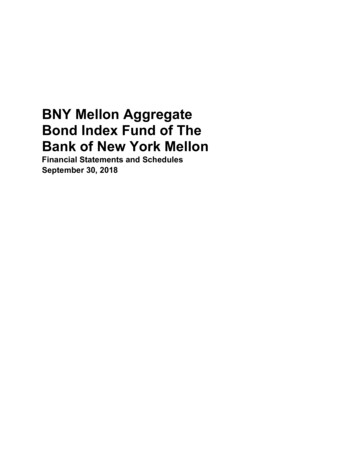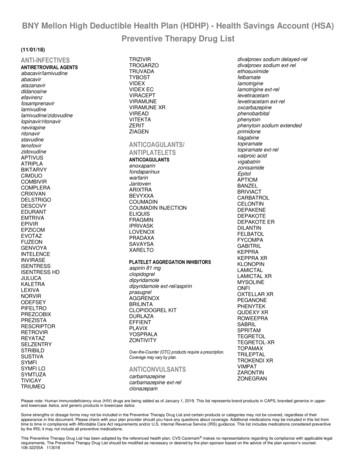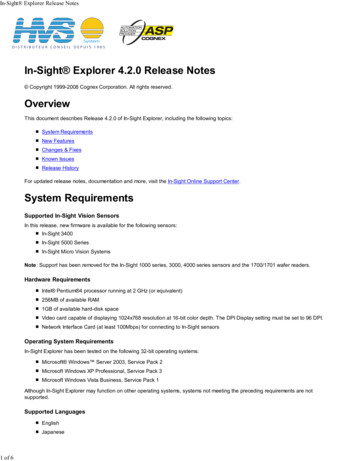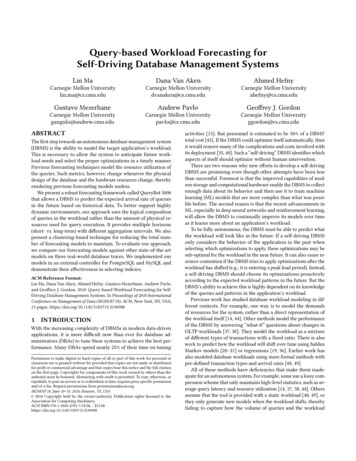
Transcription
In Plan SightNEW OPPORTUNITIES FOR MULTINATIONALCORPORATIONS TO IMPROVE RETIREMENTPLAN OVERSIGHTASSET SERVICING
IntroductionDrivers for Improved OversightRetirement plan oversight has neverbeen more important to multinationalcorporations than it is today.The drivers for improved oversight are many and varied.A NOTE ON COVID-19The most recent driver behind enhanced oversight has possibly been the leastexpected. A new coronavirus disease (COVID-19) emerged at the end of last yearand spread rapidly at the beginning of 2020. At the time of finalizing this report, thedisease had spread to nearly every country in the world. Individuals in many of theworst affected countries were in lockdown. The impact on the global economy isbeginning to show. Given the substantial fall in output and demand, the questionis not if we will enter a recession, but how bad it will be. Whilst the situation mayhave improved by the time you read this, COVID-19 is set to have a significantimpact on the world in 2020.A powerful combination of economic,business and regulatory factors promptingcorporates to seek enhanced visibility ofdata relating to performance, risks andcompliance, both at an individual planand at a consolidated level.Fortunately, the opportunities to improveoversight by making changes to thestructure of pension plans, working witha global custodian or through moreeffective use of technology have alsonever been greater.As corporates focus on sustaining cash flows, we hope this report, which focuseson opportunities for multinationals to improve oversight of retirement plans andaccurately assess risks and obligations, contains useful insights in the contextof prudent financial management. Indeed, COVID-19 has exacerbated many ofthe other drivers behind enhanced supervision, including the cost of providingdefined benefit (DB) plans. We take a closer look at the drivers before highlightingthe powerful role of technology, digitalization and data in supporting effectiveretirement plan oversight.1. THE CHANGING REGULATORY LANDSCAPEIn recent years, regulation – particularly in Europe – has been a major driver behindthe need for corporates to improve retirement plan oversight. Following the 2008financial crisis, many countries introduced reforms, which had direct and indirectimpacts on institutional investors. Increased governance demands have had aproportionately bigger impact on smaller pension funds, making it harder for themto remain viable and meet their responsibilities. The expectation is that complianceobligations will continue to increase in the coming years.More recently, IORP II, the revised EU Directive on workplace pensions, has promptedmany multinational companies that had previously taken a hands-off approach to theirEuropean plans to reassess their arrangements. In theory, IORP II aims to encouragecross-border pension activity. In reality, some of its provisions have been undermineddue to the way EU countries have transposed the Directive into national law. In theNetherlands, for example, local IORP II legislation makes it harder to move pensionassets cross-border than in the past1.IORP II is nonetheless an important directive. It seeks to strengthen pension fundgovernance, risk management and member communications. It places new emphasison environmental, social and corporate governance (ESG)-related risks. It is alsolikely to result in tougher rules in relation to ESG investment screening, engagementwith companies that pension funds invest in and impact investing—where investmenttargets must generate a measurable, beneficial social or environmental impact. Inorder to comply, a company’s headquarters must be able to monitor how local plansare meeting these obligations.1BNY Mellon report: IORP II: Challenges and Opportunities1
SpotlightBy Hans van Meerten, Professor,EU Pension Law, Utrecht Universityand member of the EIOPA occupationalpensions stakeholder groupINSTITUTIONS FOR OCCUPATIONALRETIREMENTPROVISION (IORP) IIIORP II is the revised version of the EuropeanUnion (EU) Directive on the activities andsupervision of institutions for occupationalretirement provision. IORP II, published in2016, replaces the original Directive (IORP I),which was published in 2003.EU member states had until 13 January 2019to transpose IORP II into national law. At 67articles, compared to the 24 of its predecessor,IORP II is extensive. It aims to enhance pensionfund governance, risk management and membercommunications and promote cross-borderpension activity. It also raises the profile ofESG investing.Encouraging cross-border pension activity hasbeen an objective of the IORP Directive sinceits inception. The goal of the regulators wasto make it easier for multinationals activein multiple European countries to achieveeconomies of scale.By consolidating the various occupationalpension schemes in EU member states into asingle vehicle (a cross-border IORP), companiescan streamline administration and governanceand improve financial performance.While IORP I led to the establishment of anumber of cross-border vehicles, its abilityto truly drive European-wide pension activityforward was hindered by a number of factors,including the administrative burdens associatedwith starting cross-border activity2.The inherent complexities of the Europeanpension landscape also inhibited its success.Pension schemes in each member state arecomplex and were governed both by IORP I andrelevant national pension law. For companies,there continued to be a need to assess individualcountry legislation to understand the extent oftheir compatibility and overlap.IORP II sought to address the shortcomings ofthe original Directive by revising some of itsprovisions. For example, it amended somewhatthe obligation for schemes operating crossborder to always be fully funded. Under IORPII, plans that operate cross-border can runa deficit for a limited period as long as theyimplement a recovery plan and receive localregulatory approval.However, new issues have emerged thatundermine cross-border initiatives. Theserelate mainly to the way IORP II has beenimplemented locally. As IORP II is a directive,EU member states have a degree of autonomyin relation to how they transpose it intonational law. Some countries have incorporatedelements of the directive in a way that goesagainst its aims. For example, IORP II statesthat fifty percent of members and beneficiariesmust approve a cross-border transfer oftheir pension plan’s asset and liabilities. Inthe Netherlands, two-thirds of members andbeneficiaries must approve, which makesgaining approval more challenging.22It is still too early to tell whether IORP II willtruly reignite cross-border pension provision.However, the cost and operational efficienciesmultinationals stand to gain from consolidation,along with the potential for improved financialperformance, mean companies may chooseto combine multiple (and potentially smaller)schemes into a single vehicle. As this reportoutlines, advances in technology, datamanagement and reporting may offer alternativeroutes to improved oversight and efficiency.Other aspects of the IORP II Directive are drivingcompanies to pay closer attention to theirEuropean pension arrangements. As part ofefforts to improve the sustainability of pensionschemes, IORP II emphasises ESG-related risks.Specifically, it requires occupational pensionfunds to either invest for the long-term interestof members and beneficiaries in accordancewith the “prudent person” rule, taking intoaccount the long-term impact of ESG factors, orexplicitly account for reasons why ESG factorshave not been incorporated into investmentstrategy. Demands for ESG-related reporting arelikely to increase in the pensions industry overthe coming years.EIOPA 2017 Market Development Report on Occupational Pensions and Cross-Border IORPs, BNY Mellon Report: IORP II: Opportunities and Challenges3
2. THE IMPACT OF DEFINED BENEFIT (DB) OBLIGATIONS3. ONGOING BUSINESS PRESSURESWhile regulatory changes may have put enhanced pensionoversight front of mind for multinationals, the most significantdriver behind greater supervision is the financial burdensDB plans impose on corporates’ balance sheets.At the same time, given the competitivebusiness environment, multinationals are underconstant pressure to better manage costs androot out inefficiency at the local plan level.Over the last decade, the challenge of providing DB plans hasbeen exacerbated by historically low interest rates, which haveexpanded the gap between assets and liabilities for many fundsand necessitated increased contributions from companies.Without effective oversight, it is difficult toascertain a true picture of costs—which can besignificant given the need for local reporting—or take action to reduce them. The need toscrutinize and manage costs is also promptingmultinationals to assess retirement policies anddesign, with a view to understanding their costimplications and potentially standardizing them.The shift to defined contribution (DC) has helped multinationalsde-risk their pension arrangements as DC plans in principle donot require an employer guarantee. But corporates have foundthat de-risking is not the end of the story. Local DC plans stillmaintain their own asset-liability models, custodians anddata formats.Oversight is critical to understanding what local plans are doingand gathering data to produce high level reports, as well asensure ESG policy is aligned across different local funds, withcorporate policies and for regulatory purposes.“Against a backdrop of challenging economicand competitive conditions, many companiessimply cannot afford to fund their DB schemes– shareholders are highly reluctant to bear theincreasing burdens of funding DB pensions.”Dennis PresburgHead of Asset Servicing BusinessDevelopment for Continental Europe4Another important driver is risk managementand financial oversight; multinationals havean obligation to report value-at-risk frommarket events and assess the ability of theirpension funds to meet their liabilities in specificmodelled scenarios. Local regulators such asBaFin in Germany or De Nederlandsche Bankin the Netherlands have stress tests modelledagainst historical events.Multinationals must comply not only withrequirements in the country where theirheadquarters is located, but also in everyjurisdiction where they have a local plan.In some circumstances, local funds themselvesare acting as a driver for more proactiveand overarching supervision. The low yieldenvironment has prompted many to exploreopportunities to increase allocations toalternative asset classes, such as privateequity and real estate, in order to meet theirobligations. Given the complex nature ofthese asset classes and their relatively highcost structures, there is significant valueto be gained from pooling funds to achieveeconomies of scale and access to a wider rangeof investment opportunities. To a lesser extent,these factors are also resulting in greaterpooling of mainstream asset classes suchas equities and fixed income. In order to poolfunds, standardization of data and enhancedoversight are essential.“A lot of companies still rely on Microsoft Excel forconsolidated reporting, which is time-consumingand more likely to generate errors. In recent years,more sophisticated reporting solutions haveemerged that significantly reduce these issues.”Marc RavenSenior Product SpecialistGlobal Risk Solutions5
Routes to Enhanced OversightMultinationals with multiple European or global pensionplans that wish to improve oversight have a number ofoptions available to them.PHYSICAL CONSOLIDATIONMultinationals may choose to physically consolidate theirEuropean pension schemes into a single IORP fund. This canlower fees by improving economies of scale and facilitating moreefficient asset allocation, as well as making it easier to enforcea standard investment process or single ESG policy. As outlinedpreviously, IORP II seeks to encourage cross-border pensionprovision. Many multinationals are thought to be considering thecreation of a single EU fund based in Belgium as the country’sOFP (Organism for the Financing of Pensions) structure is seen asideal for cross-border asset pooling. According to the EuropeanInsurance and Occupational Pensions Authority (EIOPA), 30% ofthe 3.7 trillion in assets held by European pension funds arelinked to multinationals’ pension plans. Belgium’s pension fundassociation PensioPlus is aiming for 10% of those multinationalsto set up a pan-European pension fund in Belgium by 2025.3VIRTUAL CONSOLIDATIONVarious factors mean that an IORP fund may not be feasible for allmultinationals or circumstances. An alternative route to achievingimproved visibility while maintaining local plan structures is towork with a global custodian, who can offer virtual consolidationthrough sophisticated reporting. This may present a more costeffective and less complex route to enhanced oversight thanphysically combining pension plan assets.“Multinationals are striving for greaterglobal oversight of their retirement plansto strengthen governance, reduce costs andultimately, secure better outcomes for theirmembers and beneficiaries.”Ileana SodaniManaging Director, Head of InternationalSales for Asset Servicing – EMEA and APAC36IPE Article: Belgium: Rolling out IORP II (September 2019)7
Towards more Flexible ReportingAdvances in technology – specificallydigitalization – and developments in datamanagement, driven both by serviceproviders and institutional investors, haveresulted in significant improvements toretirement plan reporting over the lastfew years.Huge data volumes have become a definingcharacteristic of the financial services industry inrecent years. The arrival of new and more granulardata sets mean that reporting is now far morecomprehensive than it once was. For corporates,enhanced and improved steering data, such asdata related to ESG scoring and analytics, riskanalysis and universe benchmarking, provideheadquarters with greater transparency, allowingthem to conduct a more detailed assessment ofretirement plan performance. Moreover, datacan now be more easily integrated into existinginformation sources.Institutional investors’ demand for more frequentreporting has increased. The tough economicenvironment of the last decade and volatilemarkets mean many corporates are seekinga better understanding of what is impactingperformance on a more immediate basis, sothey can accurately model and quantify risksand monitor ongoing viability more closely. It isimportant, however, for those responsible forretirement plan oversight to assess the costs andbenefits of faster and more granular data optionsas they can be expensive.Finally, there have been vast improvements inthe way data is delivered. Just a few years ago,reports were typically presented in tabularformats as PDFs. They had limited interactivityand the various stakeholders involved in planmanagement would have to run multiple reportsto gain the insights they wanted.Over time, online portals have become moresophisticated and interfaces have becomemore intuitive, enabling institutional investorsto navigate their data more easily, accessinformation in different ways and generatereports in the format of their choice. Theincreasing use of widgets has made personadriven reporting possible; individuals rangingfrom the operations managers of local plans tomore senior stakeholders, such as the group headof pensions, can build dashboards specific totheir responsibilities and based on the insightsthat matter to them. New business intelligencetools go one step further and enable corporatesto manage how the data ultimately appears.Going forward, the need for more comprehensivedata—presented in a convenient and digestibleway—is likely to increase. Pension professionalsincreasingly expect to be able to access the samedetailed data and analytical functionality on theirsmartphones and tablets as on their desktops.Moreover, as a new generation of people moveinto senior roles in the retirement industry,expectations and demands around data andreporting will change.“Advances in technology are creating new optionsfor replacing or collapsing legacy systems. Newreporting solutions enable multinationals to fulfiltheir fiduciary and reporting duties at lower costand with far greater efficiency.”Marvin VervaartProduct & Strategy, EMEA Asset Owners,Asset ResourcesRisk & ComplianceCommunicationsReportingAdminHQ OversightInfoCustomize ContentPerformance Summary40%30%20%10%0%-10%-20%Current Month3 MonthsFiscal YTD1 YearPortfolio ReturnTop Ultimate Issuer & Counterparty Exposure3 YearsBenchmark Return5 YearsESG Scores vs Account PerformanceHistorical Market Value10%ITDExcess uer 1Issuer 2PortfolioIssuer 3Issuer 4BenchmarkIssuer 5200820102012Issuer 6201420162018202040123DifferenceESG Total Score45Return (%)Environment Subscore6Social Subscore789Governance subscoreAn example of a dashboard that has been customized for a multinationals’ headquartersMultinationals may perceive having differentcustodians in different jurisdictions as a hurdleto virtual consolidation. Indeed, it is not alwayspossible for a multinational to work with a singlecustodian globally. Some corporates may wishto maintain long-established relationships withlocal providers or have decentralized structuresthat delegate the choice of custodian to localoperations. Other multinationals may be unableto commit the resources or time to selecting asingle custodian and migrating to them.Consequently, for many companies analternative solution—often described asshadow bookkeeping or master recordkeeping—may be preferable. Just like a single globalcustodian relationship, master recordkeepingenables headquarters to have full oversightthrough a simple dashboard while local planscontinue to have the granular detail theyrequire; headquarters can also access moregranular data without having to ask the localplan to provide it. Local plans do not have toprovide regular information to headquarters foraggregation and consolidated reporting. Instead,copies of SWIFT instructions ordinarily sent onlyto the local custodian are also sent to the masterrecordkeeping bank.Master recordkeeping does not fully replicatethe role of a local custodian, which would becostly and inefficient. However, by providingincreased oversight it enables multinationals tomanage costs, reduce risk and meet oversightrequirements more effectively. In addition,it provides this information in an accessiblemanner with a focus on speed and efficiencyand with options to customize reports toclient needs. Moreover, as the process of datacollection is automated (as well as other relatedprocesses such as risk reporting) local staffcan concentrate on their main roles rather thanhaving to upload information to headquarters.9
Overcoming PotentialHurdles to OversightWhile multinationals have different options available tothem to improve oversight, some obstacles remain.A common challenge is the cultural differences betweenorganizations in different jurisdictions. Irrespective of whethermultinationals choose to physically consolidate pension planassets or adopt a more sophisticated reporting solution, it isimportant to ensure that plans are open to accommodatingdifferent ways of working or expectations. This is especiallyimportant in decentralized companies, where there may beconsiderable autonomy at local level; headquarters mustcommunicate the benefits of improved oversight clearly in orderto persuade local plans to cooperate with a new approach.A further challenge is that many corporates have relatively smallteams responsible for pensions plans; while a project managerand a consultant may be appointed at headquarters level toimplement change, limited resources are often a challenge atlocal plan level where staff have to implement a new solutionwhile doing their day job. A lack of internal capacity may hinderthe ability to adopt a new approach that may ultimately result ingreater efficiency.It is also essential to recognize the specific requirements ofthe various regulatory environments where local plans operate.As mentioned, some European countries have more rigorousreporting requirements, which must be considered and managedon an ongoing basis as companies migrate to a new solution.“Despite a trending towards centralized retirementplan oversight in recent years, cultural differencescontinue to create barriers to integration.”Paul SmitHead of Business Developmentfor the Netherlands, Asset Servicing10ConclusionThe imperative to improve oversight has neverbeen greater. Multinational corporations arefinding it harder than ever to manage thefinancial burdens and risks associated withDB plans. The low interest rate environmentand changes in the business environment,which are resulting in greater competition andputting further pressure on costs, reinforcethe need to root out inefficiency at the localplan level.Some multinationals may be able to simplifytheir global pension provision to gaineconomies of scale, lower costs, improveefficiency and facilitate greater investment intechnology by physical consolidation of assetsin an IORP fund.Meanwhile, the regulatory landscape isbecoming more onerous as a result of–particularly in Europe–new rules, such asIORP II. Additional requirements focused oninvestor protection and financial stabilitywere recently announced by EIOPA and theEuropean Central Bank. ESG-related reportingburdens are also expected to increase.However, for various reasons, this optionmay not be feasible for all multinationals.An alternative option may be to work witha global custodian and leverage advancesin technology and developments indata management to implement a moresophisticated reporting solution. Theadvances now being made in terms of therange, depth, speed and customization ofdata are significant and represent a real,potentially simpler and more cost-effectivealternative to physical consolidation.The shift to DC is helping to relieve the fundingburden from corporates and de-risking theirpension plans but it does not cut complexity.Corporates that want to maintain attractiveretirement benefits and promote betterretirement outcomes for individuals, as wellas deliver value and risk management forshareholders, need to prioritize enhancedoversight.The goal of enhanced oversight of retirementplans is now within reach for all multinationalsregardless of the jurisdictions where theyhave local plans, their operational structureor their custodial arrangements. For thebenefit of existing and future pensioners andmultinationals’ efficiency and risk objectives,companies should consider their options andact accordingly.“While the environment in which multinationalsoperate is uncertain and complex, advances intechnology, data management and reporting arechanging the game, enabling them to improveoversight with more ease and efficiency.”Pieter StrikPrincipal Product ManagerAsset Servicing11
The goal of enhancedoversight of retirementplans is now within reachfor all multinationalsregardless of thejurisdictions where theyhave local plans, theiroperational structureor their custodialarrangements.
Authors:Pieter StrikPrincipal Product Manager,Asset Servicing, BNY MellonMarvin VervaartProduct & Strategy, Asset Owners,EMEA Asset Servicing, BNY Mellonbnymellon.comBNY Mellon is the corporate brand of The Bank of New York MellonCorporation and may be used to reference the corporation as a whole and/orits various subsidiaries generally. The views and opinions expressed in thisreport are those of the authors and do not necessarily reflect the views ofBNY Mellon.This material and any products and services may be issued or provided undervarious brand names of BNY Mellon in various countries by duly authorizedand regulated subsidiaries, affiliates, and joint ventures of BNY Mellon,which may include any of those listed below:The Bank of New York Mellon, a banking corporation organized pursuantto the laws of the State of New York, whose registered office is at 240Greenwich St, NY, NY 10286, USA. The Bank of New York Mellon is supervisedand regulated by the New York State Department of Financial Servicesand the US Federal Reserve and is authorized by the Prudential RegulationAuthority (PRA).The Bank of New York Mellon operates in the UK through its London branch(UK companies house numbers FC005522 and BR000818) at One CanadaSquare, London E14 5AL and is subject to regulation by the Financial ConductAuthority (FCA) at 12 Endeavour Square, London, E20 1JN, UK and limitedregulation by the Prudential Regulation Authority at Bank of England,Threadneedle St, London, EC2R 8AH, UK. Details about the extent of ourregulation by the Prudential Regulation Authority are available from us onrequest.The Bank of New York Mellon SA/NV, a Belgian limited liability company,registered in the RPM Brussels with company number 0806.743.159,whose registered office is at 46 Rue Montoyerstraat, B-1000 Brussels,Belgium, authorized and regulated as a significant credit institution by theEuropean Central Bank (ECB) at Sonnemannstrasse 20, 60314 Frankfurt amMain, Germany, and the National Bank of Belgium (NBB) at Boulevard deBerlaimont/de Berlaimontlaan 14, 1000 Brussels, Belgium, under the SingleSupervisory Mechanism and by the Belgian Financial Services and MarketsAuthority (FSMA) at Rue du Congrès/Congresstraat 12-14, 1000 Brussels,Belgium for conduct of business rules, and is a subsidiary of The Bank of NewYork Mellon.The Bank of New York Mellon SA/NV operates in Ireland through its Dublinbranch at Riverside II, Sir John Rogerson’s Quay Grand Canal Dock, Dublin 2,D02KV60, Ireland and is registered with the Companies Registration Officein Ireland No. 907126 & with VAT No. IE 9578054E. The Bank of New YorkMellon SA/NV, Dublin Branch is subject to limited additional regulation bythe Central Bank of Ireland at New Wapping Street, North Wall Quay, Dublin1, D01 F7X3, Ireland for conduct of business rules and registered withthe Companies Registration Office in Ireland No. 907126 & with VAT No. IE9578054E.The Bank of New York Mellon SA/NV is trading in Germany as The Bankof New York Mellon SA/NV, Asset Servicing, Niederlassung Frankfurt amMain, and has its registered office at MesseTurm, Friedrich-Ebert-Anlage49, 60327 Frankfurt am Main, Germany. It is subject to limited additionalregulation by the Federal Financial Supervisory Authority (Bundesanstaltfür Finanzdienstleistungsaufsicht, Marie-Curie-Str. 24-28, 60439 Frankfurt,Germany) under registration number 122721.The Bank of New York Mellon SA/NV operates in the Netherlands throughits Amsterdam branch at Strawinskylaan 337, WTC Building, Amsterdam,1077 XX, the Netherlands. The Bank of New York Mellon SA/NV, AmsterdamBranch is subject to limited additional supervision by the Dutch Central Bank(‘De Nederlandsche Bank’ or ‘DNB’) on integrity issues only (registrationnumber 34363596). DNB holds office at Westeinde 1, 1017 ZN Amsterdam, theNetherlands.The Bank of New York Mellon SA/NV operates in Luxembourg through itsLuxembourg branch at 2-4 rue Eugene Ruppert, Vertigo Building – Polaris, L2453, Luxembourg. The Bank of New York Mellon SA/NV, Luxembourg Branchis subject to limited additional regulation by the Commission de Surveillancedu Secteur Financier at 283, route d’Arlon, L-1150 Luxembourg for conductof business rules, and in its role as UCITS/AIF depositary and centraladministration agent.The Bank of New York Mellon SA/NV operates in France through its Parisbranch at 7 Rue Scribe, Paris, Paris 75009, France. The Bank of New YorkMellon SA/NV, Paris Branch is subject to limited additional regulation bySecrétariat Général de l’Autorité de Contrôle Prudentiel at Première Directiondu Contrôle de Banques (DCB 1), Service 2, 61, Rue Taitbout, 75436 ParisCedex 09, France (registration number (SIREN) Nr. 538 228 420 RCS Paris CIB 13733).The Bank of New York Mellon SA/NV operates in Italy through its Milanbranch at Via Mike Bongiorno no. 13, Diamantino building, 5th floor, Milan,20124, Italy. The Bank of New York Mellon SA/NV, Milan Branch is subject tolimiteed additional regulation by Banca d’Italia - Sede di Milano at DivisioneSupervisione Banche, Via Cordusio no. 5, 20123 Milano, Italy (registrationnumber 03351).The Bank of New York Mellon (International) Limited is registered in England& Wales with Company No. 03236121 with its Registered Office at One CanadaSquare, London E14 5AL. The Bank of New York Mellon (International) Limitedis authorised by the Prudential Regulation Authority and regulated by theFinancial Conduct Authority and the Prudential Regulation Authority.Regulatory information in relation to the above BNY Mellon entities operatingout of Europe can be accessed at the following website: https://www.bnymellon.com/RID.The Bank of New York Mellon has various subsidiaries, affiliates, branchesand representative offices in the Asia-Pacific Region which are subject toregulation by the relevant local regulator in that jurisdiction. Details aboutthe extent of our regulation and applicable regulators in the Asia-PacificRegion are available from us on request. Among others, The Bank of New YorkMellon, Singapore Branch is subject to regulation by the Monetary Authorityof Singapore. The Bank of New York Mellon, Hong Kong Branch (a bankingcorporation organized and existing under the laws of the State of New Yorkwith limited liability) is subject to regulation by the Hong Kong MonetaryAuthority and the Securities & Futures Commission of Hong Kong. The Bankof New York Mellon, Seoul Branch is subject to regulation by the FinancialServices Commission, the Financial SupervisoryWhilst The Bank of New York Mellon (BNY Mellon) is authorised to providefinancial services in Australia, it is exempt from the requirement to hold,and does not hold,
the need for corporates to improve retirement plan oversight. Following the 2008 financial crisis, many countries introduced reforms, which had direct and indirect . BNY Mellon Report: IORP II: Opportunities and Challenges IORP II sought to address the shortcomings of the original Directive by revising some of its
